In This Issue
-
Tiare Ribeaux ● Cyanovisions
-
Tabita Rezaire ● Net Decolonizing
-
Lissette Olivares ● Promethean Coevolution
-
Tina Mariane Krogh Madsen ● Body Interfaces
-
Paz Tornero ● IONI
-
Jennifer Smith ● Reva Stone Interview
-
Dr. Praba Pilar ● CO2ONIALISM in the Extractocene
-
Boryana Rossa ● Feminism and Socialism
-
Dr. Praba Pilar ● HER< E >TECH
CYANOVISIONS - PHOTOSYNTHETIC SPECULATIONS
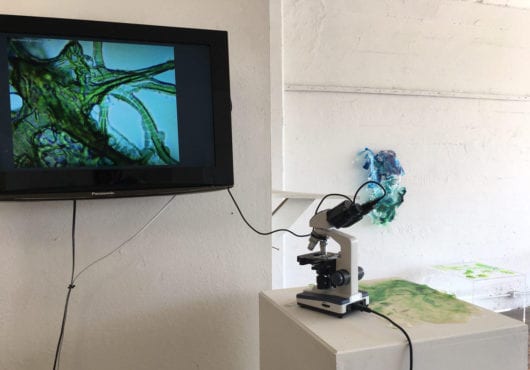
CYANOVISIONS, Tiare Ribeaux, (2018, ongoing).
Life on our planet began with slime, and will likely end in slime.
At the time when the earth became hot
At the time when the heavens turned about
At the time when the sun was darkened
To cause the moon to shine
The time of the rise of the Pleiades
The slime, this was the source of the earth
– Introduction to the Kumulipo, an ancient Hawaiian chant [1]
All other life forms depend on the workings of uncountable living, dying, and metabolizing bacteria.
There is no life without waste, exudate, pollution. In the prodigality of its spreading, life inevitably threatens itself with potentially fatal messes that prompt further evolution.
– Lynn Margulis and Dorion Sagan [2]
I start with these references because microbial, slimy textures and environments will weave in and out of this article and are an essential part of the transdisciplinary art project Cyanovisions. I share my history with algae, biotechnology and microbial life; discuss the entanglements of cyanobacteria with humans; provide details on how I use cyanobacteria and biotechnology in Cyanovisions; the intentions and permutations of this multimedia project; and how it continues to grow, like an emergent organism.
Cyanovisions 3 Minute Teaser from Tiare Ribeaux on Vimeo.
I. LAB BABIES AND EXPONENTIAL GROWTH
I WAS FIRST DRAWN TO THE landscapes of algae and slime in 2007, when I was hired to work as a lab technician at an experimental lab on the Kona Coast of Hawai’i. The lab was super-growing algae to create biodiesel. At the time I was an artist from and working in Honolulu, and saw this opportunity to experience what it was like to work in biotechnology as something that could enrich and inform my art practice. As it turns out – it changed my life, the trajectory of my art practice, and my perspective of the world.
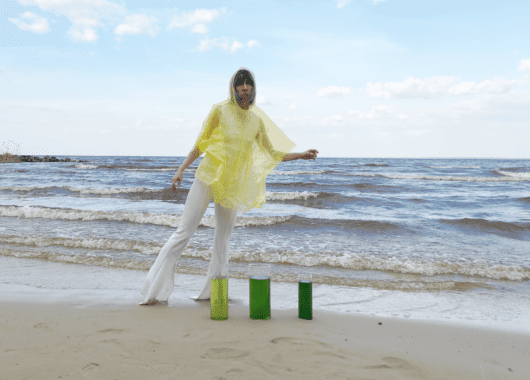
Algae Kyiv Sea Beach Tubes.
Working at the HR Biopetroleum (now Cellana) algae lab was almost like being inside of a tropical Willy Wonka factory, where instead of chocolate, there were green tubes of liquid with living organisms floating through them and giant race track ponds of green sludge next to lava rocks and the Pacific Ocean. I became entangled with the life of these microalgal species as I monitored, fed, and transferred them from small Erlenmeyer flasks to larger containers and tube systems – forming a sort of kinship with microscopic species that I had not known previously. Looking at them under the microscope was like seeing into a new universe, a view into the inner workings of Gaia. The algae grew exponentially over a few days, within a week I had aided their growth from tiny flasks to giant raceway ponds.
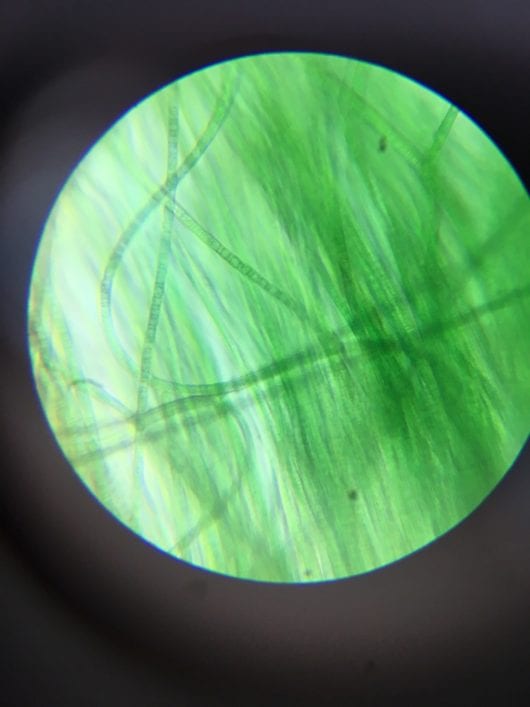
CYANOVISIONS- Initial Studies, Tiare Ribeaux, B4BEL4B Gallery, 2018.
There was something miraculous in watching life grow so fast. When they had maximized their growth, we dried and centrifuged the algae in giant vats. This created a thick slimy paste of dense microalgae biomatter, a ‘green gold’ from which rich oils could be extracted to become biofuel. There was the monotony of taking constant measurements and washing the glassware in acid baths. There was also horror, as that acid was dumped in very close proximity to the ocean, and the lab generated a massive amount of plastic waste in its operations. It felt contradictory to carry out research in this manner, in order to develop biofuels and green energy for a more ‘sustainable’ world. Unfortunately, to this day, algal fuel hasn’t been an economic venture or one that can be scaled up, as petrochemical fuel is still cheaper and fuel infrastructure has yet to change.
In the field of biology and of ‘green energy,’ there is always a duality, and for me, this provided a first-hand glimpse into the entanglements of our technologies and the effects we have on ecosystems, other species, and the earth. This duality became a multidimensionality that has followed me throughout my work and life.
After working at the algae lab, I have been drawn to the life sciences and biology, at times studying these alongside my art practice. I worked for a short time as an intern studying intertidal species, seeing the fragility of starfish that live in very specific intertidal environments in northern California and are unable to withstand small changes in salinity and acidity in the ocean. With a related team of scientists at my first algae lab, I later studied harmful algal blooms of raphidophytes off the coast of Puget Sound, taking small research vessels out on the coastal seas to collect potential toxic samples, and trying to create synthetic toxic environments in the laboratory – to mostly inconclusive results.
II. CYANOMUTATIONS ON A SLIMY PLANET
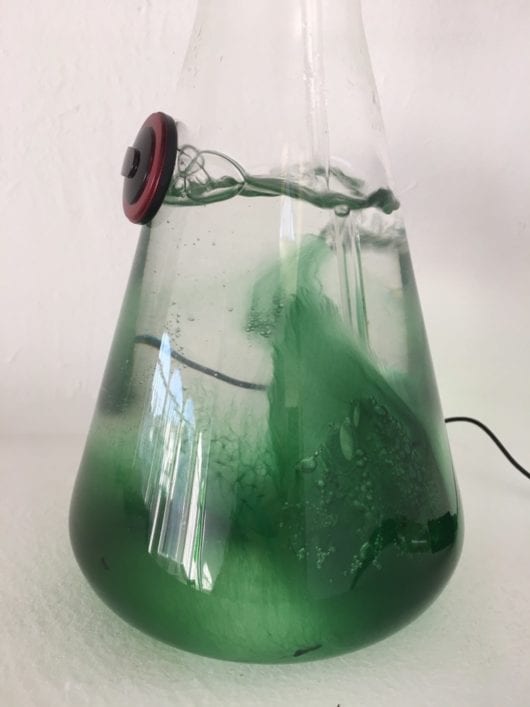
CYANOVISIONS- Initial Studies, Tiare Ribeaux, B4BEL4B Gallery, 2018.
A decade after my first stint as a lab technician, I finally began weaving what I learned working in the field of biology and biotechnology into my arts practice. I was drawn to the landscapes of harmful algal blooms – this time inland blooms of cyanobacteria or blue-green algae, which in fact aren’t algae at all, but bacteria! Incredibly ancient and magnificently interesting and innovative bacteria.
Cyanobacteria are one of the most ancient life forms; they were responsible for first creating oxygen on our planet and the first organisms able to photosynthesize, transmuting sunlight into energy. Through endosymbiosis, a process discovered by the brilliant and radical scientist Lynn Margulis, they also became the chloroplasts that all plants use to process sunlight into energy today. Cyanobacteria contain pigments that facilitate the capture of wavelengths of light in the visible light spectrum to create energy — this transmutation of sunlight produces all life: food, coal, our atmosphere, our carbon-rich energy reserves, and ultimately powers our technologies and the creation of our technologies.
Cyanobacteria also caused the Great Oxidation Event or what Dorion Sagan terms the ‘Cyanocene’ over 2.5 billion years ago — what began as an extinction event for organisms intolerant to oxygen, later spawned new heights of global biodiversity and ecological complexity. [3] Long after this emergence of life, human intervention in nature has caused a duality resulting in the untempered proliferation of ‘toxic’ algal blooms of cyanobacteria that now threaten ecologies and other species, including humans. Ironic as it is, the organisms that first created oxygen on the planet can form such thick and slimy mats on the surface of inland water bodies that they cause eutrophication events – depleting oxygen in the water, resulting in massive die-offs of other species.

Cyano Bloom, Ukraine.
What I found in my research is that toxic algal blooms are mostly caused by the human presence. Humans provide the integral ingredients to this toxic sludge – through damaging industrial and agricultural runoff and the flushing of septic tanks in homes and developments, pumping large influxes of nitrates and phosphates into the groundwater. This ends up in rivers, lakes and estuaries, and ultimately provides the precursors spawning these blooms. What happens is similar to the environment I was creating on the algal farm in Hawai’i — by inadvertently ‘over-feeding’ these nutrients to the cyanobacteria, they reproduce exponentially — growing rapidly and without the restriction of tubes or racetrack ponds. We are deeply enmeshed in these ecologies.
We are seeing these environments of cyanobacteria that are comparable to environments that existed during early earth in the Proterozoic Eon around the globe right now. It makes one rethink the scale of time — looking at the evolutionary history of these organisms and their presence and growth on the planet — what is the timescale to them? In The Time of Slime: Anthropocentrism in Harmful Algal Research, Astrid Schrader says that ‘what is called for… is a notion of time that disrupts the dichotomy of (biological) continuity and (metaphysical) discontinuity between the human and the nonhuman animal world, and this requires attention to how we get to know nonhuman others.’ [4]
Cyanobacteria, when in these aggregations, are known to cause ‘cyanotoxins’ — a melange of neurotoxins, hepatotoxins, cytotoxins, and endotoxins — which, in the cyclical nature of life, come around to adversely affect the human body. Exposure to cyano-blooms and their cyanotoxins can potentially result in pruritic skin rashes and gastrointestinal disorders. The cyanobacterial neurotoxin BMAA (beta-Methylamino-L-alanine) can cause apoptosis (cell death) of mammalian brain cells and lead to neurodegenerative disorders such as Parkinson’s Disease, Alzheimer’s Disease, and ALS. [5] There is even the alarming potential for military weaponization of biological neurotoxins from cyanobacteria. [6] Of course – ‘Harmful’ Algal Blooms and cyano-‘toxins’ are only called as such because they are harmful to us. To quote Schrader again, ‘The question that immediately imposes itself is ‘harmful to whom?” On the other side of the spectrum, recent research has shown that phycocyanin, the light capturing pigment of cyanobacteria, has anti-oxidative and anti-inflammatory effects on the human body, as well as neuroprotective and anti-cancer capabilities. [7]
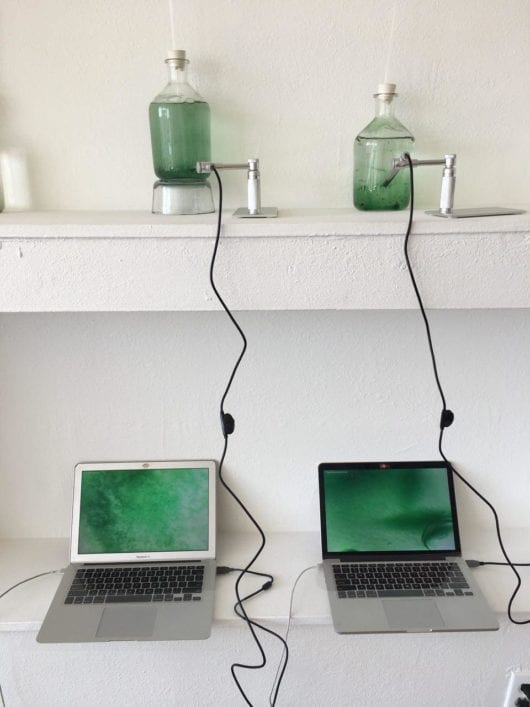
CYANOVISIONS, Tiare Ribeaux, (2018, ongoing).
I wanted to create a story that highlighted the entanglements and parallels between both humans and cyanobacteria, especially, their capacities to both create and destroy life and to blur the boundaries between humans, bacteria, and ecosystem. Although inadvertently responsible for the extinction of other species, humans also create new species and life forms through synthetic biology, genetic engineering, and artificial life.
III. CYANOVISIONS AND TRANSGENESIS

Speculative Photo Series, Ukraine.
My initial research of cyanobacteria blooms grew out of an artist fellowship I did in Kyiv, Ukraine looking at blooms in the local Dnipro river that dramatically affect the water quality for the local population. I used the tools of speculative design and storytelling for symbiotic futures in damaged ecologies. With collaborators Krolikowski Art duo, we developed a photo series that positioned me as a biohacker/scientist next to the river, siphoning off algae for biofuel and doing experiments in bioremediation in a speculative outdoor lab. After leaving Ukraine, and returning to Oakland and Northern California (where I am based), I discovered there were cyanobacteria blooms locally and I continued to build upon the narrative we began in Ukraine. The photo series transformed, like the transmutative qualities that phycocyanin uses to transmute sunlight – into a time-based media and multimedia project – a short film and numerous elements for installation called Cyanovisions.
I ordered 5 different cyanobacteria cultures and grew them in my studio, in glass flasks – which are still growing to this day. I started creating bioplastics colored by spirulina (a cyano) and phycocyanin, positioning them on my body to imagine new skins. With the help of architect and designer Dasha Ortenberg, I created a large immersive photobioreactor tube system that circulated and grew Spirulina – that could potentially be harvested for food. Cyanovisions became a transdisciplinary project combining video, fashion, installation and bioart that engaged with the tools of biotechnology in order to explore deeper narratives related to human identity, symbiosis with cyanobacteria (and other species), and our rapidly changing environment and bodies in an era of climate change.

CYANOSYMBIONTS, Bioplastic with spirulina ink, Tiare Ribeaux, 2018.
A lot of biotech companies and startups are located in South San Francisco and the South Bay, such as Genentech and 23andMe. CRISPR, the revolutionary gene editing mechanism that naturally exists within bacteria, was discovered by Jennifer Doudna and her team in Berkeley; and ODIN, the first company to sell DIY CRISPR kits online, is based in Oakland. There is also a DIY biohacking space called Counter Culture Labs that I am part of and lead an art-science initiative, as well as finally – being able to create my own experiments. Because this biotechnological landscape makes up a large part of the Bay Area, I feel it is an important and necessary topic to create work about while living here, through the lens of art.

CYANOSYMBIONTS, 3D Printed arm pieces, medical oxygen tubes, Tiare Ribeaux, 2018.
Inspired by recent experiments in CRISPR gene editing technologies such as the CRISPR babies in China, and recent research done around genetically engineering photosynthetic bacteria to exist in the cytoplasm of mammalian cells by Christina Agapakis et al, I wanted to create a speculative narrative that used gene editing to incorporate traits of cyanobacteria in humans. [8,9]
Cyanovisions imagines a future where the light harvesting pigment phycocyanin are engineered into humans – to withstand extreme climate events, and for the anti-oxidative, anti-inflammatory, and neuroprotective effects mentioned above. Traits of these organisms are engineered into our bodies not only to surpass our limitations and programmed cell death, but to protect against cyanotoxins and the toxic conditions that we have induced on the planet.
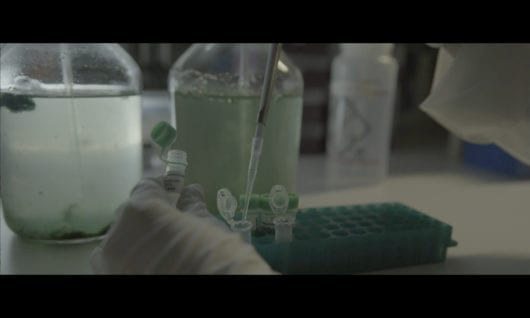
CYANOVISIONS (film still), Tiare Ribeaux, (2018, ongoing).
Dorion Sagan says, in Beautiful Monsters: Terra in the Cyanocyene, that ‘the nested pulsing interwoven energy-sensing networks of life are not confined to individuality at the animal level. The thermodynamically open complex systems of cells and organisms permit not just companionship and mating but permanent interpenetration, the merging of metabolisms. The tendency for exponential reproduction on a limited planet drives organisms not only into each other’s territories but into one another.’ [10] Cyanovisions posits potentials for biological hybridity and scientific spiritualities with microbial species that recognize the inextricable relationship of humans to those of other organisms. We ‘other’ bacterial species too often, when bacteria are not only deeply entangled with our ecosystems and keeping them in balance, but also comprise the majority of our bodies through our microbiomes – and keep those in balance as well.
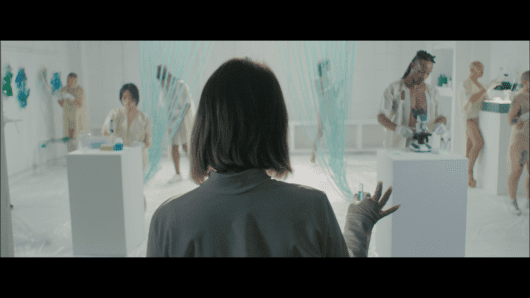
CYANOVISIONS (film still), Tiare Ribeaux, (2018, ongoing).
With these projects, I wanted to blur and distort many boundaries and ask – what does it mean to identify as human, with mostly bacterial bodies? How will we genetically engineer our bodies to survive in the extreme conditions brought about by climate change? As taboos and bioethics around genetic experimentation on the human body shift over time, what are speculative eroticisms around genetic engineering and potential laboratory sensualities and rituals that may develop? How can we imagine evolving symbiotically with our technologies? How can we reshape and rewrite our anthropocentric histories to be bacterio-centric, so we can move towards symbiotic futures, recognizing multi-species ontologies? What would the future look like if humans and cyanobacteria merged membranes, genes, and metabolisms? How could the growth of cyanobacteria bring future altered atmospheres back into balance?
This project aims to offer a radical alternative present, future (and past) to all of these questions.
IV. SPECULATIVE MULTISPECIES FUTURES, AND ONTOLOGIES

CYANOVISIONS, Tiare Ribeaux, (2018, ongoing).
Though the trajectory of culture for millennia has distanced the human body and consciousness from the chemical processes and organisms that it is composed of, it is eternally linked to forces, processes, and organisms. Cyanovisions moves beyond revealing correlations of human, natural, and sterile engineered forms and offers other ways of symbiotically living with both other species and our technologies. By integrating cyanobacteria into our built structures/bodies, and by imagining the speculative worship of bacteria and temples for photosynthesis and their growth, we may begin to shift into radical new ways of thinking about potential multispecies collaborations in these precarious times.

CYANOVISIONS (film still), Tiare Ribeaux, (2018, ongoing).
All the elements of Cyanovisions that had grown over time were folded together like strands of DNA into a short film, co-visioned and co-directed by Jody Stillwater. Stillwater really helped with the world-building aspects and to sculpt in tandem a beautiful visual narrative, along with cinematographer Danger Charles and many artist friends in Oakland. Through our collaborative efforts, we created a seductive and genre-bending portal into the Cyanoverse. Currently, Cyanovisions is still growing, replicating in forms and iterations. So far it has been shown at a solo exhibition at B4BEL4B gallery in Oakland in 2018; as an installation for the ‘Intersections’ Exhibition, which was part of the Leonardo Convening held for Leonardo/ISAST’s 50th anniversary celebration at Fort Mason Center in San Francisco in 2018; in the ‘Sustainability’ program at the Copenhagen Fashion Film Festival, at Lux Aeterna – The Special Exhibition for ISEA (the International Symposium on Electronic Arts) curated by Art Center Nabi at the Asia Cultural Center in Gwangju, South Korea, and at the MUTATIO Exhibition at Pink Grig in Moscow in 2019.
At the Leonardo Convening, it was shown as a one-channel video installation next to photobioreactors containing live cyanobacteria cultures growing in proximity to a microscope. Visitors were able to take samples of these cultures to view at different magnifications.
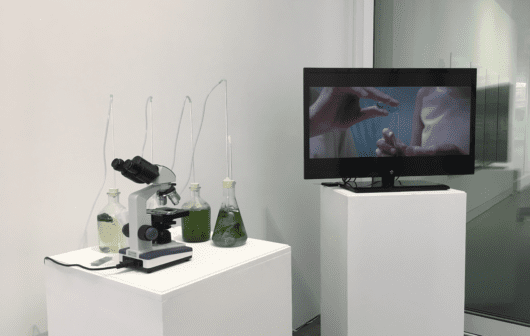
CYANOVISIONS, Tiare Ribeaux, Leonardo/ISAST Exhibition, 2019.
At B4BEL4B Gallery, the first exhibition of Cyanovisions – Initial Studies included the incubation of 5 strains of Cyanobacteria; an immersive photobioreactor, and a series of bioplastics hung on the wall and shown on acrylic displays. Cyanobacteria cultures were sonified and magnified in different variations, especially to show the weaving of biofilms produced by Oscillatoria strains, and their filaments. An immersive photobioreactor made of 1000 feet of tubing housed the growth of Spirulina.

CYANOVISIONS- Initial Studies, Tiare Ribeaux, B4BEL4B Gallery, 2018.
In the film/video, you can see landscapes of algal blooms and salt ponds juxtaposed with landscapes of Silicon Valley and the South Bay, one of the biotech capitals of the world, and the inner workings of a DIY Biology Lab nestled within. Science fact becomes science fiction as lab technicians move from routine experiments into an embodied ceremonial ritual as part of a speculative experiment using CRISPR Cas9.
I am portrayed in the short film as a scientist/biohacker collecting cyanobacteria samples in the wild, and bringing them back to my DIY Biology lab to genetically modify. It starts out looking like a routine lab experiment, until I bring a genetically modified vial of phycocyanin to what appears to be a hybrid laboratory/temple – where lab technicians go through ritual movements while isolating phycocyanin through both scientific procedures and dance. Here, it imagines a future where cyanobacteria are seen as divine creatures for having once created our atmosphere on the planet and their extremophile traits. Growth of cultures and extraction of proteins can be seen as a form of worship. As a cine-poem, this piece meditates on different states of embodiment of bacteria and water, the transformation of light, and the embodiment of transmutation of energy. The movements portrayed by dancers meditates on our bodies containing water and other symbiotic bacteria, and of these ancient cells in ancient wet, slimy environments.
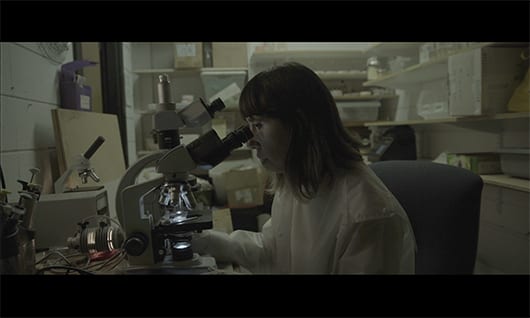
CYANOVISIONS (film still), Tiare Ribeaux, (2018, ongoing).
This piece also contemplates the future of water: imagining how we can continue to evolve with water and marine organisms, as rivers, estuaries, lakes and oceans go through the dramatic changes caused by climate change — harmful algal blooms, nutrient depletion, pollution, ocean acidification, and ocean temperature rise. It contemplates the future of the atmosphere: as we see levels of particulate matter rise in cities around the world, and locally see wildfires running rampant in California, it considers how landscapes of cyanobacteria could remediate the air quality. Margulis points out that, ‘a single photosynthetic blue-green bacterium growing and dividing under ideal conditions could, in theory, produce all the oxygen now in the atmosphere in just a few months.’
This project hopes to shift perspectives where humans are separate from nature and nature is separate from technology to a space where everything can be seen as ‘nature’… How can we connect with Gaia which we are a part of, in her rising heat, in her chaos, in her tangled web?
The most obvious answer I can think of lives within the Slime.
END NOTES:
[1] Beckwith, M. W. (1992). The Kumulipo: A Hawaiian creation chant. Honolulu: Univ. of Hawaii Pr. (A Translation of the Kumulipo, originally composed in 1700 AD by Keaulumoku)
[2] Margulis, L. & Sagan, D. (2000). What is life? Berkeley, CA: Univ. of California Press.
[3] Sagan, Dorian. ‘Beautiful Monsters: Terra in the Cyanocene.’ In Arts of Living on a Damaged Planet, edited by Anna Lowenhaupt Tsing et al., University of Minnesota Press, 2017.
[4] Schrader, A. (2012). The Time of Slime. Environmental Philosophy, 9(1), 71-93. doi:10.5840/envirophil2012915
[5] Holtcamp, W. (2012). “The emerging science of BMAA: do cyanobacteria contribute to neurodegenerative disease?”. Environmental Health Perspectives. 120 (3): a110-a116. doi:10.1289/ehp.120-a110.
[6] Dixit A, Dhaked RK, Alam SI, Singh L (2005). “Military potential of biological neurotoxins”. Informa Healthcare. 24 (2): 175-207. doi:10.1081/TXR-200057850.
[7] Jiang L, Wang Y, Yin Q, Liu G, Liu H, Huang Y, Li B. ‘Phycocyanin: A Potential Drug for Cancer Treatment.’ J Cancer 2017; 8(17):3416-3429. doi:10.7150/jca.21058.
[8] Regalado, A. (2018, November 26). Chinese scientists are creating CRISPR babies. Retrieved from: https://www.technologyreview.com/s/612458/exclusive-chinese-scientists-are-creating-crispr-babies/
[9] Agapakis, Christina M., et al. ‘Towards a Synthetic Chloroplast.’ PLoS ONE, vol. 6, no. 4, 2011, doi:10.1371/journal.pone.0018877.
[10] ibid from reference 3, Sagan, Dorian. ‘Beautiful Monsters: Terra in the Cyanocene.’
